This project is made possible through the partnership of WATER CHARITY and the NATIONAL PEACE CORPS ASSOCIATION. ![]()
This project has been completed. To read about the conclusion, please scroll down.
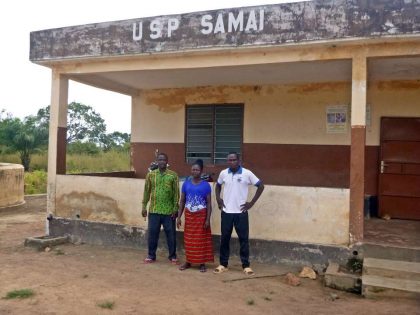 Location
Location
Samai Health Clinic, Centrale Region, Togo, West Africa
Community Description
Samai is located in the southern region of the Tchamba district near the Plateaux region to the south. An area of large tracts of forested terrain, Samai is one of the more remote sites in this suite of Water Charity borehole well clinic water systems. The village is roughly 1,100 inhabitants, though the clinic serves a larger surrounding population of over 4,000, a community of subsistence cultivators farming soy, maize, millet and yams.
The transformation of soy into “soya”, what we know as “tofu”, is a common source of household income though to what extent is questionable as everyone seems to sell to a very limited market. There is a propensity to cultivate more soy than grain staples such as maize resulting in a shortage of household stock relatively soon after harvest, requiring households to purchase grain at a time when the prices are high.
The dominant ethnic groups are Kabyé and Losso who settled in the region after migrating south from the Kara region in search of more fertile farmlands. Samai is a more mobile population than most. Young men leave the village to work in Nigeria while other Togolese migrate to the area to farm for a season or two before leaving. This is unusual as most rural communities appear to be relatively stable, except for the Fulani herdsmen.
The health clinic was built in 2013 by Plan International when the village was deemed large enough to support a government-assisted center. As is typically the case for all rural clinics labeled as USP (the first tier of a government clinic) in Togo, the community supports all the staff with the exception of the head nurse through funds raised from the sale of services and medicines. There is no electricity in Samai and as such the clinic is powered by solar panels sufficient to provide some lighting. The refrigerator for medicines and vaccines is powered by gas.
The center sees approximately 250 patients per month with an average of 7 births during this time. Treatment of malaria heads the list as the most common ailment followed by parasites, respiratory diseases and motorcycle injuries when brothers return from Nigeria for the holidays with their new motorcycles and get taken for a spin by local first-timers.
Problem Addressed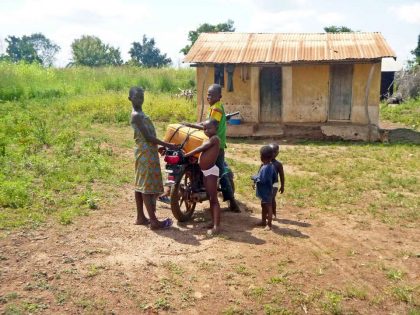
At the time of construction, the only water source was a shallow well at the village chief’s compound approximately 500 meters from the center. In 2014 Plan International installed a 65-meter borehole well with a hand pump. While the center was equipped with indoor plumbing, no provisions were made to facilitate the transition from manually carrying water into the clinic to a gravity-fed system. The lack of running water is particularly onerous for the midwives and their patients as relatives of the women are often required to provide additional water during and post-birth for clean-up. The cloths covering the birth tables which are provided by the woman’s relatives are then washed outside by the well – an unsanitary practice.
While the delivery platform is equipped with a discharge vent, the vent itself is inadequately sized resulting in the manual removal of excess blood and tissue to a pit outside the clinic. The entire process is unhygienic and endangers the health of the clinic staff, and particularly the midwives through constant contact with blood and other human waste.
Project Description
Under the guidance of the Department of Hydraulics and Sanitation’s regional office in Sokodé and with support from the Ministry of Health regional director who identified clinics with the most critical need, this project will “rehabilitate” an existing borehole well located at the Samai health clinic. This project proposes to upgrade a 60- to 100-meter borehole well at the Samai clinic, equipped with the following:
• An electric submersible pump,
• a 4.5-meter high cement block water tower,
• a 2 meter3 polyethylene tank
• piping to the main intake valve at the clinic
The submersible pump will be run using a gas-powered generator as there is currently no electric power in the community. The local drilling company selected, Plomberie Génerale de Réalisation de Forage, in operation since 1998 and based in Tchamba, has extensive experience drilling and rehabilitating deep borehole wells throughout Togo and regionally in Burkina Faso, Benin and Nigeria.
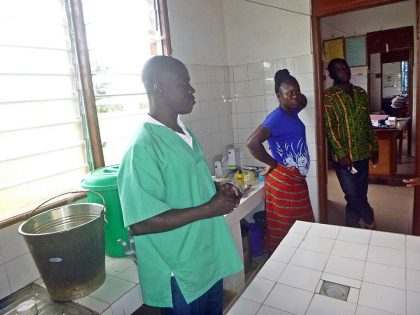 Project Impact
Project Impact
Number of people affected by the project: 4,200
Project Administration
This project will be managed by Anne Jeton, hydrologist and Returned Peace Corps Volunteer (RPCV), Burkina Faso (’82-’85) and Returned Peace Corps Response Volunteer (RPCRV), Togo (’16 -’17). Anne was sent to Togo on behalf of Water Charity to develop and administer new projects, and to coordinate with the Peace Corps.
Monitoring and Maintenance
Along with staff from the Department of Hydraulics and Sanitation who will monitor the well “indefinitely” (the well data becomes part of the official borehole well database, and as such is included in periodic field monitoring by technicians based in each Prefecture), the contract for well drilling states a one-year guarantee provided by the drilling company. Problems with pump and borehole functioning are typically resolved in the first month of use.
Proper screening of the borehole and submersible pump placement relative to the static water table often mitigate the most common problems. However, any mechanical problems surfacing in the first year will be the responsibility of the drilling company.
The clinic staff will be responsible for maintaining a well repair account which will be funded from the sale of medicines. The clinic will decide a nominal fee for water use should the water account be insufficient, or the community will be asked to contribute directly to the costs.
Project Funding
This project has been funded by an anonymous donor.
Conclusion of Samai Clinic Borehole Water System Project – Togo
This project was managed by Anne Jeton, hydrologist and Returned Peace Corps Volunteer (RPCV), Burkina Faso (’82-’85) and Returned Peace Corps Response Volunteer (RPCRV), Togo (’16 -’17).
Project Name: Samai Health Clinic Borehole Well Water System, Centrale Region, Togo
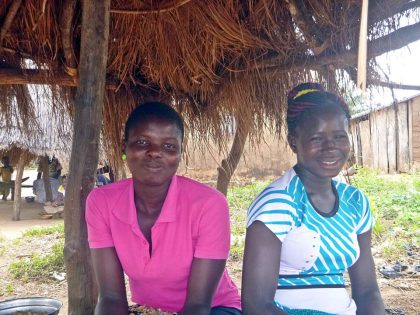 The purpose of the borehole water system project at the Samai health clinic was to address a lack of both potable and year-round water, either the absence of or nonfunctioning indoor plumbing, and the lack of hygienic disposal of afterbirth blood and tissue.
The purpose of the borehole water system project at the Samai health clinic was to address a lack of both potable and year-round water, either the absence of or nonfunctioning indoor plumbing, and the lack of hygienic disposal of afterbirth blood and tissue.
The maternity delivery room was equipped with a sink, faucet and running, potable water, and through additional outside funding; a floor drain and a discharge chamber, both plumbed to a dedicated subsurface cement-lined and ventilated septic tank. Delivery room waste (blood and tissue) can now be dispensed with directly in the maternity room in a safe and hygienic manner, rather than hand-carried by the midwives to an outdoor pit or in many cases poured into the latrines.
The scope of the project entailed “rehabilitating” the existing borehole well (flushing out accumulated sediment and organic matter inside the well casing), replacing the existing hand-pump with a submersible electric pump, building a water tower with community access points, and establishing a gravity-fed system to provide for indoor plumbing. A “pump test” was run to determine the well’s productivity and in turn the hydraulic properties of the aquifer. The pump was run for several hours at a rate like actual use and the declining water table (drawdown) was measured at regular intervals. The Samai borehole was drilled to a depth of 71 meters and has a yield of 2,300 liters/hour which is more than adequate to supply both the clinic needs and those of the surrounding households. The pump test also indicated a rapid refilling of the borehole, implying even when run at the maximum yield rate, the well should recover quickly and not result in significant lag times. Simply put, the hydraulic conditions of the well are favorable to ensure a sustainable water supply for many years to come (assuming the system is well maintained).
Water samples from both the borehole well and the original clinic well were taken and sent to the Regional laboratory in Sokodé, the regional capital, for a complete microbial and an inorganic compound analysis. The results of this analysis indicate zero presence of any of the disease-causing bacteria tested (E Coli, Salmonella, Fecal Streptococci, Enterococci and a general category of thermotolerant Coliforms) in the new borehole well.
Numerous visits were made during the well installation by the Water Charity Coordinator and the government hydrologist to oversee construction and to ensure the clinic and community leaders understood the responsibilities associated with maintaining and ensuring sustainable water supply. A final visit by the Regional Director of hydraulics insured the borehole well and the associated delivery system met all the driller’s contract requirements and functionality.
An official technical opening concluded the project with a presentation by the driller on the borehole well components, brief discourses by the Department of Hydraulics Regional Director, village leaders, the Water Charity coordinator, and a representative from the regional ministry of health. As the representative for Water Charity and its donor(s), the Coordinator reinforced previously discussed themes of maintenance and upkeep through the active participation of a community water committee and a clinic repair account, to manage public access to the well in a non-disruptive manner to the clinic staff and patients, and most importantly to take responsible ownership of this valuable resource.
CONCLUSION AND IMPACT: 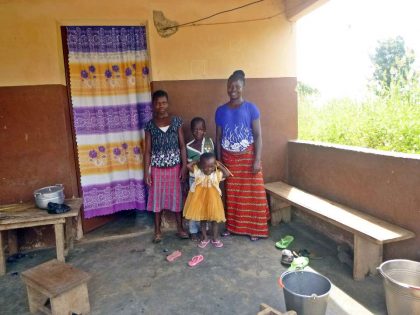
The Samai clinic serves a population of approximately 4,200 people, including the neighboring villages, who will directly benefit from a more hygienic health clinic. The community development liaison estimated perhaps as many as 1,000 inhabitants may utilize the community access point. The clinic anticipates seeing a rise in births as there is now running water and female relatives are no longer obliged to fetch water for the patient, in addition to an overall improvement in hygiene.
The clinic staff will use access to potable water to encourage better overall hygiene, as most of the disease-causing bacteria in the community water sources are due to fecal transmission by both animals and humans. The clinic staff, particularly the midwives and their assistants (which often include female relatives) will be better protected against blood-borne diseases as afterbirth material (blood and tissue) will be dispensed in a rapid and efficient manner, significantly reducing exposure.
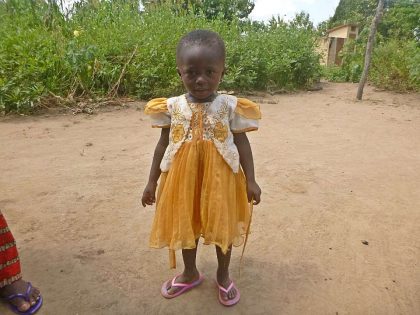 The Regional Director of the Department of Hydraulics stated in his technical report that the Samai health clinic borehole well water system has fully succeeded in meeting both the local and national objectives for potable water.
The Regional Director of the Department of Hydraulics stated in his technical report that the Samai health clinic borehole well water system has fully succeeded in meeting both the local and national objectives for potable water.
The Department of Hydraulics, the Ministry of Health and staff at each rural health clinic served by this project have repeatedly been astounded at the expediency with which funding was made available thus allowing work to begin within weeks of submitting the project request. Thank you, donors and Water Charity! The efficiency of work that followed was due in large part to the incredible efficiency, planning, and hard work by the local drilling company’s crew. The Regional Director and the hydrogeologist at the Department of Hydraulics and Water in Sokodé also contributed their time, vehicle and expertise to ensure all technical aspects of the project conformed to modern standards and have assured their continued presence as the borehole wells are now part of the national water database and monitoring program.
Having the government of Togo involved from the beginning in this suite of health clinic projects, from the selection of health centers to technical oversight and continued monitoring by the Ministry of Water officials, has confirmed the importance of not doing community projects as isolated NGOs. This last point is critical to continued success as most water projects in Togo are implemented without government oversight, leading to a myriad of problems none the least being poor technical implementation and little to no continued oversight.
The Samai project was implemented in concert with five other health center water system projects, scattered over two districts – all of which were completed on schedule. The community of Samai offers its sincere thanks and gratitude to the donor(s) for this valuable water resource. As they say here “l’eau est la vie”. Water is life, and the cleaner the water the longer and more satisfying life will be! Un grand merci!